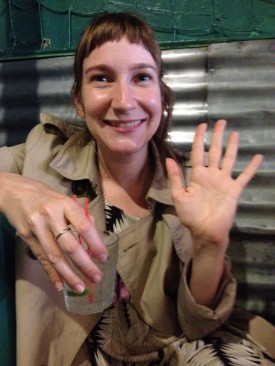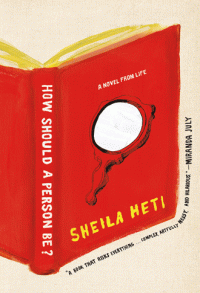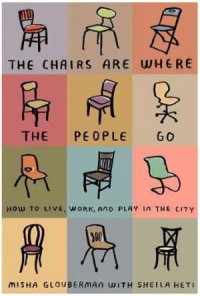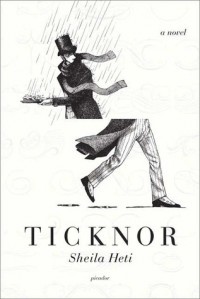"The Culture Decides What It Wants": Sheila Heti on Writing, Youth and Beauty
by Jessica Ferri

I don’t know a single person who wouldn’t benefit from reading Sheila Heti’s new novel, How Should a Person Be?, a rumination on art, friendship and the other major questions of existence. This “novel from life” features a character named Sheila, who lives (as the author does) in Toronto. In the beginning of the book, Sheila’s friends Margaux and Sholem, both painters, decide to have an “ugly painting competition,” to see who can create the ugliest painting, a process which proves more difficult than expected. In the meantime, Sheila struggles with the challenges of her friendship with Margaux, her inability to write a commissioned play about women, and a sexual obsession with a man named Israel. Combined, these conflicts lead her to the question: “how should a person be?”
You may already know of Heti, from her collection of short fiction, The Middle Stories
, or her first novel, the delightful Ticknor — or even as Lenore Doolan in Leanne Shapton’s fictional auction catalog, Important Artifacts. Last year, she published The Chairs Are Where the People Go, a strange self-help-y type book on human interaction with her friend Misha Glouberman (who appears, by the way, as a character in this new novel). In this email conversation, she and I ended up talking about a wide range of things, from competition between women and why we get crushes, to the freight put on female characters to be “likeable,” the greatness of Chris Kraus’ book I Love Dick, and ugliness.
JESSICA: The first thing I wanted to ask you is, the book is subtitled as “a novel from life,” and the characters in it — you, Margaux, Sholem and Misha — are all real folks. What did the three of them think of the book? Have they read it? Were they involved in the process of writing it, or did it come as a surprise to them?
SHEILA: Well, they all had different thoughts and complex thoughts, of course, and they mostly read it all the way along, not just at the end. Certainly Margaux read about 40 drafts. Even before it was a book, she read what would become the Prologue and was like, “This is the best thing you’ve ever written; this should be the beginning of your next book.” When somebody you’re close to says something like that, it’s hard to ignore. Then when Sholem read it near the end of the process, he didn’t even tell me what he thought; he only told Margaux, who was very discreet, but made me think that it was hard for him. He, especially, was twisted into a new shape for the novel.
All of them knew I was taping [our conversations]. They could see the tape recorder! So no, it wasn’t a surprise to any of my friends. Misha was involved in many ways; for one thing, he told me that the book we wrote together — The Chairs are Where the People Go — couldn’t be part of How Should a Person Be? (At one time I wanted them to be the same book; I thought they were the same book.) And Margaux… well, it’s impossible to underestimate how large a part of the process she was: I was talking to her about art and travelling with her the entire time I was working on it; she cast me in her movie; we shared a studio. She changed my brain. She told me many times, “It’s not good enough, it’s not done,” which is the best, most useful thing for a writer to hear. I don’t know if any of them “like” it, but they let me publish it! That’s all that matters.
JESSICA: Among so many strands of this book, one that really appealed to me was the one about your friendship with Margaux. In the beginning of the book you write that you didn’t really have any friends until you were 25.
SHEILA: My character didn’t!
JESSICA: Personally, I’ve found that it’s more difficult to maintain friendships outside of structured environments (college, workplace). Then there are stereotypes that women have to work against (i.e. women are too competitive with each other to truly be friends), and yet your friendship with Margaux in the book is both personal and professionally collaborative. What defines a friendship for you?
SHEILA: The usual things: affection, interest, intimacy, love. As I get older, I’m more interested in people who want to be in it for the long haul. That makes me feel safer and like I don’t have to rush things.
As for the “competition between women” thing: I think it’s difficult to have a relationship with anybody: boys with boys, girls with girls, girls with boys… the lot. I don’t see the reputed competitiveness, really. Mostly I see smart women and women with power wanting to help each other and encourage each other and support each other in all sorts of ways. Perhaps there’s competitiveness in female friendships that are based on going out and picking up the hottest guy. But I don’t believe that’s the basis for most female friendships. I think the stereotypes exist because there isn’t a lot of honest reporting about how things really are now. Perhaps there’s something politically to be gained from perpetuating the idea that women are naturally dangerous for other women. The truth is, everyone’s a little dangerous, not only women for women.
JESSICA: When did you first start thinking about writing this book? You mentioned earlier that you originally conceived it as part of The Chairs are Where the People Go, or that the two were one in the same. How did that change?

SHEILA: The beginnings of both books were murky. I didn’t think of the writing I was doing for How Should a Person Be? as writing that would become part of a novel until February of 2007, and the earliest writing in the book dates from early 2005. I was just writing and trying to figure out ways to write that involved being part of the world, not apart from it — sitting in a room all alone. So I began taping my friends in 2006, and transcribing our conversations. I had been reading very different versions of the Bible (including a hilarious adaptation for teens that was made to look like a teen magazine) because I was thinking about how the Bible is the ultimate book that intersects with life. Around that time, a friend’s marriage split up, and the wife sent me an angry email — her language seemed grand and “Biblical”; she criticized me for encouraging him to divorce her, when the opposite was true! I was very afraid for him embarking on a new life. But I think that was the first email I turned into a numbered passage because it reminded me of certain passages in the Bible, with that moral and frightening tone.
So anyway, I was doing all these different kinds of writings, then in 2006 I went to Spain and wrote 60 pages of a book in which my friend Misha Glouberman was the protagonist. He was trying to make Toronto into a better place, and I called it The Moral Development of Misha. I can trace the book I later wrote with him, The Chairs are Where the People Go to, that failed thing, but in The Moral Development he was a character of my own invention, and in Chairs he was just speaking as himself, which was better; less fakety-fake.
JESSICA: The Biblical aspect of this is interesting. You touch on the history of the Jewish people briefly in the novel. Do you consider yourself religious? To what extent is your identity tied to being Jewish, or Canadian, if it is at all?
SHEILA: I mean, I am Jewish — and I am Canadian. I wouldn’t say I’m religious or patriotic, nor is my family. We celebrated the major Jewish holidays when I was a kid, and I loved the holidays, and I went to Hebrew school. We sang the Canadian national anthem every morning at school. I’m definitely not American. My dad adored Pierre Trudeau. And I sometimes feel scared when I see the American flag. I come from a place that’s much more skeptical about self-certainty and grandness. When I was a kid, America was the place that had everything, and Canada was the place that had American advertisements for things you could never get in Canada, like certain lip glosses, which made me miserable at 13.
JESSICA: Is there a literary “scene” in Toronto in the same way there is in New York? As a writer would you ever want to live in New York?
SHEILA: There is an active literary scene here, but of course it’s different from the scene in New York. I wish I had astute things to say about the differences, but I haven’t spent enough time in either.
Honestly, I’m not sure I would want to live in New York as a writer. I lived and wrote there for one summer and found myself with this great sense of hurry, like I needed to be writing for the magazines and sort of constantly adding to culture — you want to be part of the moment and the conversation and one of its voices. That felt more important than thinking slowly and taking my time. I like being in a place where I can think and take my time and not feel swept up in a system that’s constantly spitting out culture, which is how I felt there. It’s of course exciting. But here it may be better for me: I feel very clear about what I want to do and what’s important to me to do. I can live and work at my own rhythm, not the city’s rhythm. Toronto’s a good city, and big — my friend and I walked east yesterday for 4-and-a half-hours and we were nowhere near the outskirts. I have a good life here. Also, I think all of contemporary literature shouldn’t be about Brooklyn. That seems really bad.
JESSICA: In the book, Margaux claims that “her words floating from separate from her body” is her worst fear — and yet, this could be a description of the act of writing. I wonder, does it matter at all what part of this novel is fiction and what isn’t fiction? Is there such thing as “fiction” and do we need labels like “fiction” or the more complicated “women’s fiction”?

SHEILA: Yeah, it’s a great description of writing.
It doesn’t really matter for the reader, what’s fiction in my book or not, though not knowing does create an anxiety and a curiosity, which interests me. It’s more of an unsettling experience to read something that hovers between invention and fact. I feel it as a reader, too, like when I read Ben Lerner’s Leaving the Atocha Station. Maybe we want to know what’s “true” from what’s “fiction” so we can know what’s possible in our own lives, and these days we mostly only trust narratives “from life” as being able to communicate future possibilities. I think, on some level, we do turn to narratives to help us predict our own futures; like if I do A, B will probably result, because B is what happened to Anna Karenina, or Lauren Conrad.
I think fiction is a useful label, because it means that things have been deliberately shaped to resemble an archetypal truth, or a metaphoric truth, rather than a literal truth, which is more what journalism is. Journalism is shaped, too, but I think there’s a difference between newspaper reportage and fiction, and that has to do with the goals of the writer: are you trying to depict events as they happened as reliably as you can, as they might have been witnessed by anyone? That seems hard, and I could never make that my ambition, because I have a really bad memory, and I don’t care what really happened. What “really” happened doesn’t interest me.
“Women’s fiction” doesn’t sound like anything but a slur to my ears.
JESSICA: You recently read at an event with Chris Kraus, who is one of my favorite writers. Her book, I Love Dick, delighted me with its brutal descriptions of sex, desire, and her personal (and critical) account of the experience of the female artist.
There’s a lot in How Should A Person Be? that reminds me of I Love Dick, in particular the chapters about Israel and the blowjob talk and the “Interlude for Sex” chapter. Can we talk about this? I don’t really know what to ask you, aside from telling you that these parts of the book were refreshing and thrilling to read.
SHEILA: I read I Love Dick in the summer of 2008, and I’m sure it influenced my book. It was the greatest thrill in the world reading it; her courage and nakedness and intelligence, and the brutality of the whole thing; how heartbreaking it is in its depiction of being a woman in a realm where men are much more easily accorded respect–in her case, the academic/art world. Chris falls for Dick partly because he has the privilege of being a recluse and being respected and admired at the same time. A woman who is a recluse isn’t admired and hunted down; she just disappears. So I think she kind of covets the cultural position he has, but being a woman, she can’t easily have it, so — next best thing — she wants to have him. My therapist would sometimes say to me when I had a crush, “What does that person have that you don’t?” because it was her view that we have crushes on people because they have something we don’t, or exhibit qualities that are underdeveloped in ourselves. If you can figure out what that is and cultivate it in yourself, maybe the crush will disappear. But in I Love Dick, Chris can never easily have what Dick has. She hopes to have his power by linking herself to him.
JESSICA: There’s definitely a link between her behavior in the relationship with Dick and her takedown of the art world. So one thing I don’t think I’ve made clear yet is how muchI love How Should A Person Be?. It’s a gem of a book and I love that, rather than placing the main focus on the sexual relationship with the character Israel, you choose to explore the much more complicated friendship between two women — two female artists, at that.

SHEILA: Yeah, I’ve been very interested in friendship. My last book, Ticknor, was about the friendship between two men. With this one, I really wanted to write a book about painting and art, and art in our time. Actually, I wanted to write a book about the history of art! So this book came out of thinking about art, way more than thinking about sex.
JESSICA: Something else that I Love Dick and How Should A Person Be? have in common is that they both defy categorization, and I’m a reader who embraces that wholeheartedly (Out of Sheer Rage is another favorite). Do you think it was the unconventionality of the book that made it a hard sell to publishers in the U.S.? Or was it the sex passages? What was the reasoning editors gave you when they turned the book down?
SHEILA: I loved Out of Sheer Rage, too!
I have no idea what made it a hard sell. One editor said, “Oh sweetie. Maybe you and Margaux should get famous first and then publish this book.”
Usually editors don’t give you thoughtful or satisfying reasons for rejecting something. For one thing, they’re often too busy to write detailed rejections; for another, their dislike is usually a gut reaction, and those are hard to put into words. I think most people prefer what they’ve seen before, with a twist. That gives people a feeling of excitement. If you’re not doing that, it’s harder. Of course, sometimes rejecting a book has to do with a projection about what “the public” wants, or maybe the marketing department doesn’t get it, or maybe your last books didn’t sell well enough. My editor, Sarah Bowlin at Henry Holt, really loved this book, and she totally understood it. I was lucky to find someone so in synch with me, and it, and so smart about every aspect of editing and publishing.
JESSICA: Did you ever think about giving up on its publication in the States or were you determined to find it a publisher in America?
SHEILA: Neither. I don’t remember feeling worried or determined or hopeless. I felt okay. I thought, If people want to read it there, it will work out. A book’s life can’t be controlled by its author. The culture decides what it wants to do with your book, or your film, or whatever. Take Lena Dunham — did she expect the Criterion Collection would want Tiny Furniture, her first feature? She was just making a movie, and trying to make it great, like so many people.
JESSICA: Lena Dunham is awesome. I was out to dinner with some people a few weeks ago, and we were discussing “Girls,” and someone at the table said they didn’t like Tiny Furniture because they found her to be “unlikeable.” I jumped out of my skin! First of all, I personally think she’s incredibly likeable. And secondly, who cares?! Is Woody Allen likeable?
I’m obsessed with how comfortable Lena Dunham is with her body. I was telling a friend that it’s hard to live in New York where every woman ever is probably a model and she just looked at me like I was crazy and said “Who cares?!”
SHEILA: I totally agree with you — her character is likeable, and even if she isn’t, who cares? Why do characters have to be likeable? Female characters especially have to be likeable, which is crazy. But is Achilles “likeable”? Is King Lear “likeable”? Characters aren’t there for us to like them; they’re instructional.
Part of what feels similar about my book and Lena’s work is this question of ugliness; what does it mean to be ugly? Can one be ugly and still appear in the world (and I do not think Lena’s ugly, I think she’s beautiful, but her distance from that model-like beauty is part of where our attention goes…). Can you even make art unless you allow yourself to be ugly, which is a huge part of being human? And of course, allowing yourself to be ugly is a huge part of being funny.
I think it’s really refreshing how — in the case of her movie — we’re seeing things from the POV of the girl that guys don’t want to fuck. So the guys look different, too. Lena is not your typical protagonist. Even the Woody Allen characters were desired! My god! By the best women!
JESSICA: I’m intrigued by the idea of allowing oneself to be ugly to make art. Is it essential to making art? Maybe. Because I think “ugly” can mean a lot of things, most than just physically ugly. I guess what I’m saying here is “ugly” can be a combination of being confident and also selfish.
SHEILA: Yeah. I think you do have to allow into your art the ugliness that’s part of everything. Ryan Trecartin is brilliant at that, and his work is sublime. Same with Harmony Korine. His aesthetic is totally ugly, and yet it’s also the most beautiful: I’ll always remember the strip of bacon taped to the blue tiles above the bathtub in Gummo. It was there for no reason, and it was just sublime! In my book, Margaux says that for her, ugliness is anything that’s really tight — something trying to be perfect, beautiful, contained, which doesn’t let any of the world in. I didn’t agree before, but now I can see it.
JESSICA: In the novel, when the character that’s based on you realizes your marriage is the “brick wall,” did you mean that as, standing in front of your ability to create? There are artists who think committed relationships + art is just not possible, then you have Mary Gaitskill (in your interview with her for The Believer!) saying that all women writers need a wife, like Virginia Woolf had Leonard.
SHEILA: I don’t know. But the older I get, the more I realize it’s possible to make art in any condition: traveling, in one place, in a good relationship, a miserable one, sleeping around, sad, content. One’s state doesn’t matter as much as one imagines. When I was twenty, I was always trying to find or create the perfect condition in which to write. Now I don’t think it exists — the perfect condition — and I don’t even think it’s important. Possibly it’s even better to be in an uncomfortable spot.
JESSICA: One of the novel’s crucial pivot comes during a conversation about two white men going to Africa — when you begin to question the role of art versus the role of charity, or, philanthropy. One thing that strikes me about this book is its relevance to recent events like the Kony/Invisible Children controversy. Also, I don’t know if it’s my age (I’m 27) but this year has been the year when suddenly I was struck with the question “What am I doing?” and “Is it enough/ Is it relevant?” I know so many people who are coming to the stage in their lives — I’m not sure if age has much to do with it.
SHEILA: I started this book when I was 28. I do think its preoccupations have to do with a certain moment in life, where there are these expectations and the fear of not fulfilling them, or not even quite knowing what they are, which I think gets more intense as one gets deeper into one’s twenties, and which then (at least in my experience) eases up in one’s early/middle thirties.
Though probably this “what am I doing?” state can crop up at any age.
JESSICA: I’m glad to hear that it eases up in the thirties, because I am exhausting myself preoccupied with these questions 24/7. I would recommend your book to almost every single person I know, especially women my age. There are moments that are so comforting, mantra moments. There’s also a lot of humor! One of my favorite scenes in the one in the copy shop.
SHEILA: What are the comforting mantra moments?
JESSICA: Well, one of my favorites is the realization about one’s parents — thinking of your parents as “complete,” but then, as you reach adulthood you don’t feel complete at all: “in what seemed like a stratosphere, another stratosphere entirely — but is this. This is the absolute outer limit of the human universe.”
SHEILA: This is really nice and useful for me to read. Thanks!

JESSICA: I loved Leanne Shapton’s Important Artifacts; how did she approach you about playing Lenore in the book?
SHEILA: I love that book, too. We were friends, a bit, at the time. Now we’re better friends, since doing the book. Leanne is from Toronto and for the past six years I’ve been living in the apartment she used to live in (though one woman lived here between us). I guess we were talking about this book she wanted to write, and either I said I’d love to play Lenore, or she said, “You should play Lenore.” I was going to be in New York that summer, anyway, so it was kind of perfect, because she photographed it all summer long.
JESSICA: Do you see How Should A Person Be? as a culmination of your work, as in all your books are connected, or are they leading very separate lives?
SHEILA: Not a culmination, but yes, I understand how they’re all connected, and in response to each other, and what I was trying to learn how to do with each book.
JESSICA: Do you have any writing rituals? A routine, when you’re working on something? Things you like to eat?
SHEILA: I have no rituals. I write with no routine, but I’m working all the time. In the mornings I eat chocolate and cookies and drink coffee or tea. I wish I had a healthier routine but it takes too much energy to keep oneself healthy and fit and well fed. When I am healthy and fit and well fed, I feel weird, almost too good, it’s not familiar. I like it, though.
JESSICA: In the beginning of the novel you write, “one good thing about being a woman is we haven’t had too many examples yet of what a genius looks like.” Who are the female geniuses that do exist and who are the women working now you admire?
SHEILA: I don’t know what “genius” means anymore. The word used to be so concrete to me, and now it’s like little particles and I can’t really see it. It would be weird of me to just accept that word at face value, which I can’t anymore! It seems like a “small man” word to make humans bigger than they can truly be, to make them as big as the universe, but the universe really is bigger.
JESSICA: Well, “genius” is a difficult word. Then, who are the female artists that you admire at this moment?
SHEILA: I love the writers Helen DeWitt and Amanda Filipacchi, and the poet Olena Kalytiak Davis, and Jhumpa Lahiri and Alice Munro and Tamara Faith Berger and Janet Malcolm and Anne Carson and Lena Dunham, Margaux Williamson, Miranda July, Leanne Shapton, Sarah Manguso, I can go on and on… The artists Annie Pootoogook and Xaviera Simmons are excellent. Agnes Varda is brilliant. And I’ve got to mention my favourite novelist, Jane Bowles, even though she’s dead.
Related: Talking To Lean Dunham About Being A “Girl” and Male Muses And Inner Dicks: A Conversation With Kate Christensen
Jessica Ferri is a writer living in Brooklyn who loves revenge fantasy films, books that defy categorization, and food blogs. Photo by Kenneth Goldsmith.
